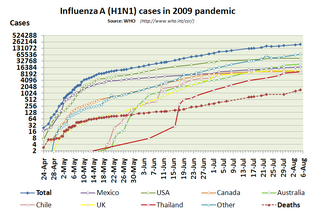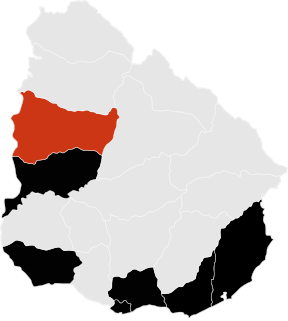
The 2009 flu pandemic, an influenza outbreak commonly known as "swine flu", affected Portugal from May 2009 to early 2010. The outbreak caused 122 deaths in the country.

The 2009 flu pandemic, an influenza outbreak commonly known as "swine flu", affected Portugal from May 2009 to early 2010. The outbreak caused 122 deaths in the country.
On 4 May, there was one confirmed case in Lisbon, Portugal, but it did not represent any concern, because the risk of transmission was no longer present at that time. [1]
On 1 June, Ana Jorge, the Portuguese Health Minister, confirmed the second case in Portugal, a 33-year-old man who travelled from the United States, first landing in Frankfurt, Germany. The case was reported at São João Hospital, Oporto. [2] On 30 June, five new cases were announced in Portugal elevating the total number of cases to 18. [3]
The first known cases resulting from human-to-human transmission were reported on 4 July (one in Azores, and the other one in Lisbon). [4] On 7 July, the first school was closed down for prevention, in Lisbon, as well as a kindergarten in Azores. The next day the first case was confirmed in the Braga district, making the total cases 61. As of 14 July, there were a total of 96 confirmed cases in Portugal. [5] On this day, it was also announced that Faro's Hospital would join, on 15 July, the set of hospitals in the country capable of receiving patients infected with the A/H1N1 flu virus. [6] Total cases rose to 154 on 20 July. [7]
Government officials stated that the worst-case scenario in Portugal would be 25% infection with a mortality of 0.1%, i.e. 8700 deaths. [8]
The outbreak started to spread more rapidly in September; on the 13th, Portugal had 9618 cases officially confirmed. The first death was reported on 23 September. [9] By 28 October, there had been four deaths - two men, one woman and one child [10] - and there were more than 25,000 cases confirmed. As of 4 December, there were 121,677 cases confirmed and 24 deaths. The final death toll, reported in May 2010, was 122. [11]

André Marques is a Brazilian actor, TV host and entertainer.

This article covers the chronology of the 2009 novel influenza A (H1N1) pandemic. Flag icons denote the first announcements of confirmed cases by the respective nation-states, their first deaths, and relevant sessions and announcements of the World Health Organization (WHO), the European Union , and the U.S. Centers for Disease Control (CDC).

In March and April 2009, an outbreak of a new strain of influenza commonly referred to as swine flu infected many people in Mexico and parts of the United States causing severe illness in the former. The new strain was identified as a combination of several different strains of Influenzavirus A, subtype H1N1, including separate strains of this subtype circulating in humans and in pigs. Spain was the first country in continental Europe to report cases of swine flu, in late April 2009.

This article deals with the status and efforts regarding the 2009 swine flu pandemic by country and continent/region.

In March and April 2009, an outbreak of a new strain of flu, popularly known as swine flu was discovered to have infected several people in Mexico and the states of California and Texas in the United States. On April 28 Costa Rica became the first Central American country to report the outbreak of the virus, with a confirmed infection. As of November 4 the Costa Rican Ministry of Health had 1,596 confirmed cases, 1,275 pending cases, 8,000 already discarded, and 38 deaths.

The 2009 swine flu pandemic in Brazil began on April 25, 2009, with two people, spreading to 34 over the first two weeks. CDC calculate that Africa and Southeast Asia, which have 38% of the world's population, accounted for a disproportionate 51% of the deaths.

The influenza A virus subtype H1N1 arrived in Argentina in late April 2009, through air traffic contact with endemic areas, especially Mexico and the United States.
The 2009 flu pandemic in South America was part of a global epidemic in 2009 of a new strain of influenza A virus subtype H1N1, causing what has been commonly called swine flu. As of 9 June 2009, the virus had affected at least 2,000 people in South America, with at least 4 confirmed deaths. On 3 May 2009, the first case of the flu in South America was confirmed in a Colombian man who recently travelled from Mexico – since then, it has spread throughout the continent. By far, the most affected country has been Chile, with more than 12,000 confirmed cases, 104 deaths, and the highest per capita incidence in the world.

The 2009 flu pandemic in Asia, part of an epidemic in 2009 of a new strain of influenza A virus subtype H1N1 causing what has been commonly called swine flu, afflicted at least 394,133 people in Asia with 2,137 confirmed deaths: there were 1,035 deaths confirmed in India, 737 deaths in China, 415 deaths in Turkey, 192 deaths in Thailand, and 170 deaths in South Korea. Among the Asian countries, South Korea had the most confirmed cases, followed by China, Hong Kong, and Thailand.

The 2009 swine flu pandemic in North America, part of a pandemic in 2009 of a new strain of influenza A virus subtype H1N1 causing what has been commonly called swine flu, began in the United States or Mexico.

The 2009 flu pandemic in Europe was part of a pandemic involving a new strain of influenza, subtype H1N1. H1N1 is commonly called swine flu. The pandemic infected at least 125,550 people in Europe. There were 458 confirmed deaths in Turkey, 438 confirmed deaths in Russia, and 457 confirmed deaths in the United Kingdom.

The Influenza A (H1N1), also known by the name of swine flu, arrived to Uruguay on May 27, 2009.

The Influenza A (H1N1), also known as the swine flu, was detected in Venezuela on 28 May. The first infected person was a 22-year-old man in San Antonio de Los Altos, Miranda State. He was participating on a meeting in Panamá, and returned to Venezuela carrying the virus
Henrique José de Sousa Neto is a Portuguese entrepreneur, industrialist and former member of the Portuguese parliament for the Socialist Party. He founded the company Iberomoldes in 1975 and became one of the most noted businesspersons in the Portuguese engineering-related industry. Henrique Neto was the first candidate to step up for the 2016 Portuguese presidential election.

The 2014 Portugal legionellosis outbreak was an outbreak of legionellosis in multiple cities of the Lisbon district in Portugal, caused by the release of Legionella bacteria from the cooling towers of a fertilizer plant in Forte da Casa, Vila Franca de Xira. It began on 7 November 2014 and affected mostly people in Póvoa de Santa Iria, Forte da Casa and Vialonga, in the municipality of Vila Franca de Xira. Paulo Macedo, the Portuguese Health Minister, declared the outbreak extinct on 21 November. The outbreak resulted in 375 cases and 12 casualties.

The 2021 presidential election was held in Portugal on 24 January. The incumbent President, Marcelo Rebelo de Sousa, was reelected for a second term.

The COVID-19 pandemic in Portugal is part of the pandemic of coronavirus disease 2019 caused by severe acute respiratory syndrome coronavirus 2. On 2 March 2020, the virus was confirmed to have reached the country when it was reported that two men, a 60-year-old doctor who travelled to the north of Italy on vacation and a 33-year-old man working in Spain, tested positive for COVID-19. On 16 March 2020, the first death from COVID-19 was reported in Portugal.

The COVID-19 pandemic in Cape Verde is part of the worldwide pandemic of coronavirus disease 2019 caused by severe acute respiratory syndrome coronavirus 2. The virus was confirmed to have reached Cape Verde in March 2020.
Events in the year 2022 in Portugal.